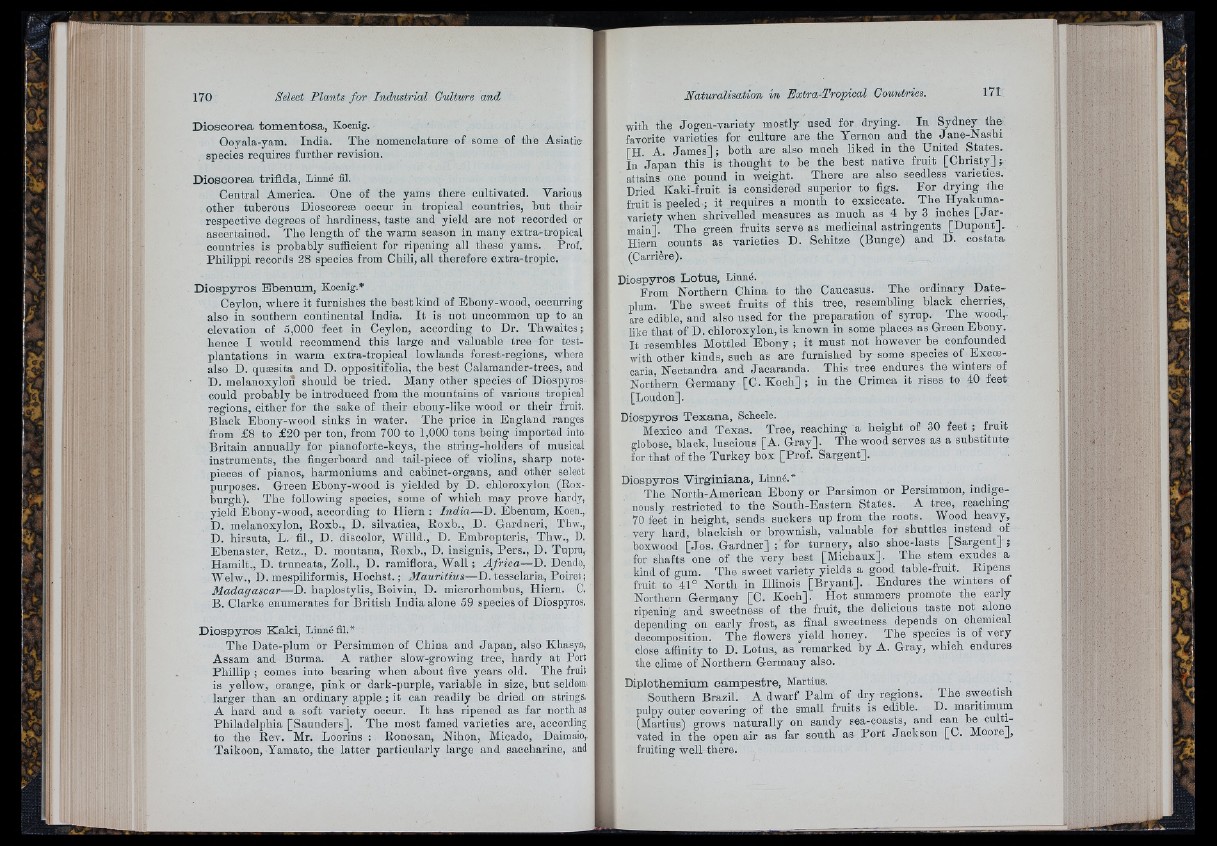
D io s c o r e a tom e n to s a , Koenig.
Ooyala-yam. India. The nomenclature of some of the Asiatic
species requires further revision.
D io s c o re a tr ifld a , Linné fil.
Central America. One of the yams there cultivated. Various
other tuberous Dioscoreæ occur iu tropical countries, hut their
respective degrees of hardiness, taste and yield are not recorded or
ascertained. The length of the warm season in many extra-tropical
countries is probably sufficient for ripening all these yams. Prof.
Philippi records 28 species from Chili, all therefore extra-tropio.
D io sp y ro s E b e n um , Koenig.*
Ceylon, where it furnishes the best kind of Ebony-wood, occurring
also in southern continental India. I t is not uncommon up to an
elevation of 5,000 feet in Ceylon, according to Dr. Thwaites ;
hence I would recommend this large and valuable tree for test-
plantations in warm extra-tropical lowlands forest-regions, where
also D. qnæsita and D. oppositifolia, the best Calamander-trees, and
D. melanoxylon should be tried. Many other species of Diospyros
could probably be introduced from the mountains of various tropical
regions, either for the sake of their ebony-like wood or their fruit.
Black Ebony-wood sinks in water. The price in England ranges
from £8 to £20 per ton, from 700 to 1,000 tons being imported into
Britain annually for pianoforte-keys, the string-holders of musical
instruments, the fingerboard and tail-pieoe of violins, sharp note-
pieces of pianos, harmoniums and cabinet-organs, and other select
purposes. Green Ebony-wood is yielded by D. chloroxylon (Roxburgh).
The following species, some of wliich may prove hardy,
yield Ebony-wood, according to Ilie rn : In d ia—D. Ebenum, Koen.,
D. melanoxylon, Roxb., D. silvática, Eoxb., D. Gardner!, Thw.,
D. hirsuta, L. fil., D. discolor, Willd., D. Embropteris, Thw., D.
Ebenaster, Retz., D. montana, Roxb., D. insignis, Pers., D. Tupru,
Hamilt., D. truncata, Zoll., D. ramiflora. Wall ; A fr ic a—D. Dendo,
Welw., D. mespiliformis, Höchst.; Mauritius—D.tesselaria, Poiret;
Madagascar—D. haplostylis, Boivin, D. microrhombus, Hiern. C.
B. Clarke enumerates for British India alone 59 species of Diospyros.
D io sp y ro s K a k i, Linné fil.*
The Date-plum or Persimmon of China and Jap an , also Khasya,
Assam and Burma. A rather slow-growing tree, hardy a t Port
Phillip ; comes into bearing when about five years old. The fruit
is yellow, orange, pink or dark-purple, variable in size, but seldom
larger than an ordinary apple ; it can readily he dried on strings.
A hard and a soft variety occur. I t has ripened as far north as
Philadelphia [Sannders]. The most famed varieties are, according
to the Rev. Mr. Loorins : Ronosan, Nihon, Micado, Daimaio,
Taikoon, Yamato, the latter particularly large and saccharine, and
with the Jogen-variety mostly used for drying. In Sydney the
favorite varieties for culture are the Yernon and the Jane-Nashi
[H. A. James] ; both are also much liked in the United States.
In Japan this is thought to he th e best native fruit [Christy]
attains one pound in weight. There are also seedless varieties.
Dried Kaki-fruit is considered superior to figs. For drying the
fruit is peeled ; it requires a month to exsiccate. The Hyakuma-
variety when shrivelled measures as much as 4 by 3 inches [ J a r-
main]. The green fruits serve as medicinal astringents [D u p o n t].
Hiern counts as varieties D. Schitze (Bunge) and D. costata
(Carrière).
Diospyros L o tu s , Linné.
From Northern China to the Caucasus. The ordinary Date-
plum. The sweet fruits of this tree, resembling black cherries,
are edible, and also used for the preparation of syrup. The wood,,
like th a t of D. ohloroxylon, is known in some places as Green Ebony.
It resembles Mottled Ebony ; it must not however be confounded
with other kinds, such as are furnished by some species of Excce-
caria, Neotandra and Jacaranda. This tree endures the winters of
Northern Germany [C. Koch] ; in the Crimea it rises to 40 feet
[Loudon].
Diospyros T e x a n a , Soheele. ^
Mexico and Texas. Tree, reaching a height of 30 feet ; fruit
globose, black, luscious [A. Gray]. The wood serves as a substitute
for that of the Turkey box [Prof. Sargent].
Diospyros V irg in ia n a , Linné.*
The North-American Ebony or Parsimon or Persimmon, indigenously
restricted to the South-Eastern States. A tree, reaching
70 feet in height, sends suckers up from the roots. Wood heavy,
very hard, blackish or brownish, valuable for shuttles instead of
boxwood [Jo s. Gardner] ; for turnery, also shoe-lasts [Sargent] ;
for shafts one of the very best [Michaux], The stem exudes a
kind of gum. The sweet variety yields a good table-fruit. Ripens
frnit to 41° North in Illinois [B ry an t]. Endures the winters of
Northern Germany [C. Koch]. Hot summers promote the early
ripening and sweetness of the fruit, the delicious taste not alone
depending on early frost, as final sweetness depends on chemical
decomposition. The flowers yield honey. The species is of very
close affinity to D. Lotus, as remarked by A. Gray, which endures
the clime of Northern Germany also.
Diplothemium c am p e s tr e , Martius. ^ ^
Southern Brazil. A dwarf Palm of dry regions. T h e sweetish
pulpy outer covering of the small fruits is edible. D. maritimum
(Martins) grows naturally on sandy sea-coasts, and can cultivated
in the open air as far south as P o rt Jackson [C. MooreJ,
fruiting well there.